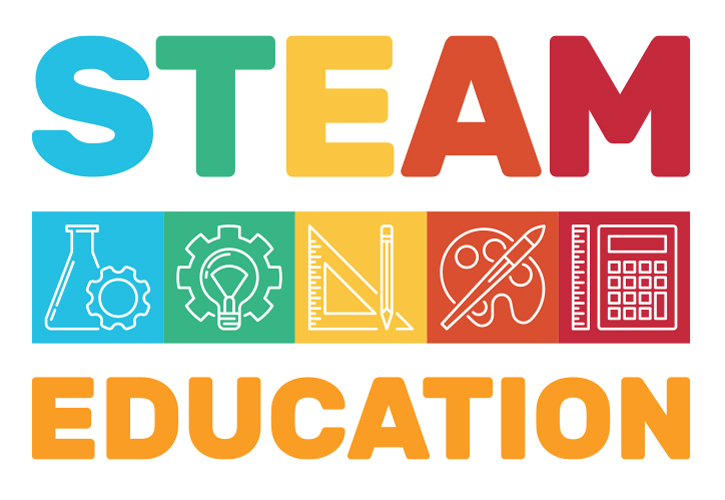Integrated Science, Technology, Engineering, Arts, and Mathematics (STEAM) education has captured the attention of elementary schools, school districts, the media, policy-makers, those involved in informal learning, and professional organizations as a
way to engage students as creative thinkers, makers, and doers.
Along the way, STEAM has become intertwined and sometimes described interchangeably with the idea of a ‘makerspace’, which is often described as a space for students to collaborate, work, and learn together through ‘making’ using
consumables, reproducibles, and technology. When planned intentionally, a makerspace can provide a great opportunity for students to engage in the Engineering Design Process or Design Thinking. Makerspaces can be a place where meaningful student learning
occurs, when the focus is on deep student learning of concepts, skills, and ideas. However, just because students are in a makerspace or just because students are using technology, doesn’t mean they are engaged in standards-based STEAM learning.
Thus , it is important to untangle the use of makerspaces and making from the purpose and intent of STEAM learning.
"Just because students are in a makerspace or just because students are using technology, doesn’t mean they are engaged in standards-based STEAM learning."
All too often, when embarking on STEAM in a school or district, too much focus is placed on designing the “STEAM Lab” or “Makerspace” and not enough focus is placed on the instruction that will take place in that space. STEAM is
not about crafts, fun activities, shiny new gadgets, or the latest technology. While having access to plentiful resources and the latest technology is great, it is not necessary to implement STEAM effectively nor is it sufficient for implementing
STEAM effectively. The focus of STEAM should first and foremost be centered on the problem-based STEAM inquiries in which students will be engaged and the relevant concepts students will be using to solve those problems. With these foci undergirding
the STEAM learning experience, students deepen their understanding of important concepts and their usefulness in solving integrated and complex problems.
We believe that STEAM instruction—that is the planning, implementing, and assessing of STEAM inquiries—should foundationally be grounded in grade-level appropriate mathematics and science content and practices, with engineering, technology,
and the arts incorporated in ways that naturally fit and enhance the experience. STEAM is about creating transformative learning experiences for students where they engage in solving complex problems in their school, community, and beyond in order
to generate solutions to make the world a better place. STEAM learning is about providing each and every student access to learning opportunities that make the mathematics and science visible in ways that are connected to their lives.

Five strategies for keeping STEAM focused on meaningful disciplinary content and practice learning:
1. Begin with the end goal in mind.
Consider what you want students to take away from the STEAM inquiry. Don’t try to do too much. Instead, focus on just one targeted mathematics and science content standard, then consider the mathematical practices and science and engineering practices
of focus. From there, include technology and arts integration where they meaningfully fit.
2. Carefully develop your problem statement.
Your problem statement is the purpose of your STEAM inquiry and should be interesting to students, spark their creative problem solving, and have clear parameters. At the forefront, you should honor your students’ unique lived experiences
and contributions. Culturally relevant teachers position students as constructors of knowledge in a collaborative community-based learning space. You might even ask your students what they know about community issues that connect to mathematics or
science and develop your inquiry from there. Alternatively, connecting to local community partners could stimulate a relevant and purpose-driven inquiry.
3. Continually draw students back to the purpose.
STEAM inquiries take time and it’s easy to get lost in the different parts of the problem-solving process. For example, at one phase of the STEAM inquiry, students might be conducting research to determine their course of action. In another, students
might be creating a blueprint of a design. At the end, students might be co-constructing their justification and explanation for their design to present to stakeholders. At different points during the STEAM inquiry, students can become so focused
that they forget to continually think back to the bigger picture. Make sure to take a few minutes often to revisit the problem statement and make sure all paths to solve the problem reflect a solution that addresses the issue at hand.
4. Continually draw students back to the mathematics and science content and practices.
During STEAM, students use important mathematics and science to work towards their solutions, but it’s our job to ensure that they realize they are using mathematics and science and that they understand the related concepts, phenomena, and
skills related to the disciplinary content of the STEAM inquiry. By continually asking content focused purposeful questions and engaging students in meaningful discourse centered on the content and practices, we can keep the mathematics, science,
and other STEAM disciplines at the forefront of every STEAM inquiry.
5. Assess student learning.
Student learning should be assessed throughout a STEAM inquiry. A focus should be placed on assessment of the entire process, not just the finished solution or product. Importantly, formative and summative assessment of STEAM inquiries should include
disciplinary content and practice focused assessment – asking students to articulate the mathematics and science they learned and used to explain and justify their design decisions and solutions. Placing a disciplinary content focus on STEAM
assessment keeps the focus on meaningful student learning.
Authors:
Dr. Sarah B. Bush is an associate professor of K–12 STEM education and program coordinator of the mathematics education PhD track at the University of Central Florida in Orlando, Florida.
Dr. Kristin Cook is an associate professor of science education at Bellarmine University and serves as the associate dean of the School of Education.